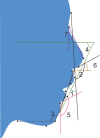Soft Tissue Esthetic Changes Following a Modified Twin Block Appliance Therapy: A Prospective Study
- PMID: 32904097
- PMCID: PMC7450202
- DOI: 10.5005/jp-journals-10005-1759
Soft Tissue Esthetic Changes Following a Modified Twin Block Appliance Therapy: A Prospective Study
Abstract
Aim: Achieving a satisfactory facial esthetics is of utmost importance in the practice of orthodontics. Cl II div 1 patients often suffer from numerous adverse facial characteristics which may impair their social well-being. The objective of the current study was to evaluate the esthetic changes in such patients by using a modified twin block appliance.
Materials and methods: Seventy adolescent patients with mandibular deficiency consecutively underwent treatment with a modified twin block appliance for a mean period of 13 months. Soft tissue analyzes of Burstone and Mcnamara were applied to evaluate the changes before and after the treatment. The esthetic changes before and after the therapy were compared using parametric paired t tests analysis. p values less than 0.05 were considered significant.
Results: Facial convexity, lip incompetence, upper lip protrusion, and columellar inclination significantly decreased (p < 0.05) while Merrifield's Z-angle nasolabial angle, lower lip length, and mentolabial angle significantly increased (p < 0.05). Vertical facial height ratio, lower lip protrusion, upper lip length as well as nasal projection and inclination, did not change significantly (p > 0.05).
Conclusion: Our findings indicated that a modified form of the twin block appliance can be substantially effective in the improvement of several aspects of patients' facial balance with minimum untoward effects.
Clinical significance: Adolescents suffering from mandibular deficiency can gain substantial facial balance with the twin block appliance. The whole face attractiveness, however, is another subject and should not be conflicted with the facial balance.
How to cite this article: Shahamfar M, Atashi MHA, Azima N. Soft Tissue Esthetic Changes Following a Modified Twin Block Appliance Therapy: A Prospective Study. Int J Clin Pediatr Dent 2020;13(3):255-260.
Keywords: Esthetics; Facial profile; Soft tissue; Twin block.
Copyright © 2020; Jaypee Brothers Medical Publishers (P) Ltd.
Conflict of interest statement
Source of support: Tabriz University of Medical Sciences Conflict of interest: None
Figures





Similar articles
-
Evaluation of the External Soft Tissue Changes Following the Correction of Class II Skeletal Malocclusion in the Adolescence Period Using Removable and Fixed Functional Appliances: A Systematic Review and Meta-Analysis.Cureus. 2024 Mar 27;16(3):e57070. doi: 10.7759/cureus.57070. eCollection 2024 Mar. Cureus. 2024. PMID: 38545423 Free PMC article. Review.
-
Accelerating Treatment of Skeletal Class II Malocclusion using Fixed Twin Block Appliances.Int J Clin Pediatr Dent. 2018 Mar-Apr;11(2):146-150. doi: 10.5005/jp-journals-10005-1501. Epub 2018 Apr 1. Int J Clin Pediatr Dent. 2018. PMID: 29991869 Free PMC article.
-
Dentoskeletal effects of class II malocclusion treatment with the modified Twin Block appliance.J Clin Exp Dent. 2019 Dec 1;11(12):e1093-e1098. doi: 10.4317/jced.56241. eCollection 2019 Dec. J Clin Exp Dent. 2019. PMID: 31824588 Free PMC article.
-
Evaluation of Changes in Soft and Hard Tissues of TMJ among Class II Division 2 Patients after Prefunctional Orthodontics and Twin Block Functional Appliance Therapy: A Prospective MRI Study.Int J Clin Pediatr Dent. 2022 Sep-Oct;15(5):479-488. doi: 10.5005/jp-journals-10005-2439. Int J Clin Pediatr Dent. 2022. PMID: 36865723 Free PMC article.
-
The extraction of permanent second molars and its effect on the dentofacial complex of patients treated with the Tip-Edge appliance.Eur J Orthod. 2002 Oct;24(5):501-18. doi: 10.1093/ejo/24.5.501. Eur J Orthod. 2002. PMID: 12407946 Review.
Cited by
-
Comparison of Twin Block appliance and Herbst appliance in the treatment of Class II malocclusion among children: a meta-analysis.BMC Oral Health. 2024 Feb 26;24(1):278. doi: 10.1186/s12903-024-04027-w. BMC Oral Health. 2024. PMID: 38409017 Free PMC article.
-
Efficacy of a modified twin block appliance compared with the traditional twin block appliance in children with hyperdivergent mandibular retrognathia: protocol for a single-centre, single-blind, randomised controlled trial.BMJ Open. 2023 Nov 27;13(11):e071959. doi: 10.1136/bmjopen-2023-071959. BMJ Open. 2023. PMID: 38011986 Free PMC article.
-
Interceptive Treatment of Class II Malocclusion in Pediatric Patients Using Clear Aligner Mandibular Advancement: A Systematic Review Following PRISMA Guidelines.Cureus. 2025 Apr 11;17(4):e82089. doi: 10.7759/cureus.82089. eCollection 2025 Apr. Cureus. 2025. PMID: 40357108 Free PMC article. Review.
-
Comparison of cephalometric measurements of the Twin Block and A6 appliances in the treatment of Class II malocclusion: a retrospective comparative cohort study.Ann Transl Med. 2022 Aug;10(16):876. doi: 10.21037/atm-22-3762. Ann Transl Med. 2022. PMID: 36111042 Free PMC article.
-
Comparing Direct Measurements and Three-Dimensional (3D) Scans for Evaluating Facial Soft Tissue.Sensors (Basel). 2023 Feb 22;23(5):2412. doi: 10.3390/s23052412. Sensors (Basel). 2023. PMID: 36904614 Free PMC article.
References
-
- Sarver DM. Special considerations in diagnosis and treatment planning. In: Graber LW, Vanarsdall R, Vig KW, et al., editors. Orthodontics current principles and techniques. St.louis: Mosby; 2017. pp. 245–246.
-
- Proffit WR. Malocclusion and dentofacial deformity in contemporary society. In: Proffit WR, Fields HW, Sarver DM, et al., editors. Contemporary Orthodontics. 5th edn., St Louis: Mosby; 2013. p. 8.
-
- McNamara JA, McClatchey LM, Graber LW. Optimizing orthodontics and dentofacial orthopedics: Treatment timing and mixed dentition therapy. In: Graber LW, Vanarsdall R, Vig KW, et al., editors. Orthodontics current principles and techniques. St.louis: Mosby; 2017. p. 404.
LinkOut - more resources
Full Text Sources
Medical
